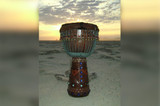Reiki Drumming
Reiki is a Japanese healing technique that was brought over to the United States in the 1970s. It is thought to have originated in Tibet, and has been practiced in many forms throughout the East. The basis of Reiki is "hands-on healing" that uses inherent energy in order to open chakras and provide healing to the body. Reiki promotes wellness, relaxation, release of negativity and the intention to balance and strengthen energy within the body.
There are many Reiki practitioners throughout the world. The interest in Reiki's ability to heal and promote wellness has even attracted the attention of hospitals and clinics, and more of these medical facilities are encouraging their staff to learn Reiki as a way to help patients with chronic illness and other health concerns.
Tools that are commonly used during Reiki treatments include stones and crystals, pendulums, herbs and oils. Drumming has also become a tool in the Reiki practitioner's practice. Some sessions may include recorded drumming to help a client relax and open up to the energy flow, while other practitioners are beginning to incorporate a drum itself into their work.
With the healing benefits of drumming, as well as the ability of Reiki to facilitate health, it's a natural combination of elements designed to increase a client's ability to be healed.
Using a drum during Reiki is a matter of the ever-important intention of healing. While a typical Reiki session may involve the "scanning" of a client’s body by the Reiki practitioner, drumming serves a dual purpose. It can not only be a scanning tool, but the drum sounds can also be used to increase the healing intent.
In addition, the healing sounds of the drum may help bring in extra elements of healing, making the Reiki session much more beneficial to the client. It is recommended that when integrating drumming into Reiki, that the practitioner uses a hand-held drum, such as a Djembe, frame drum (shown in video above) or other small drum. Since the drum itself will be held above the client’s body, be sure to select a drum that is light enough to hold without fear of the drum slipping. Drums may be played with the hand or with a mallet, and Reiki practitioners should not be concerned with the sounds that are produced from the drum, either rhythmically or in volume or tone. The feedback that is received through the energy flow between practitioner and client may be the definition of the rhythm that is played, and in a sense, both the practitioner and client may be able to experience the inherent sounds of healing by drumming during a Reiki session.
The tools with which Reiki practitioners incorporate into their session work vary according to their lineage, tradition and knowledge. Many practitioners are always on the lookout for new ways to bring their healing gifts to a higher level, ultimately benefiting the client as well as the practitioner’s work. While drumming may not be a calling for everyone, much like Reiki, it is another way to take natural forms of healing and combine them into a more powerful wellness experience.
Recent Posts
-
What is the Best Size Djembe for Beginners?
If you're new to the world of percussion and interested in learning the djembe, you're in for a t …16th Jul 2024 -
The Benefits of Becoming a Drumming Teacher: Transforming Passion into Profession
Why become a drumming teacher? Becoming a drumming teacher is an excellent way to share your pas …22nd May 2024 -
What Makes the Djembe Drum a Spiritual Instrument in African Music?
Origin and history of the Djembe drum The Djembe drum originates from West Africa and holds sign …16th May 2024



